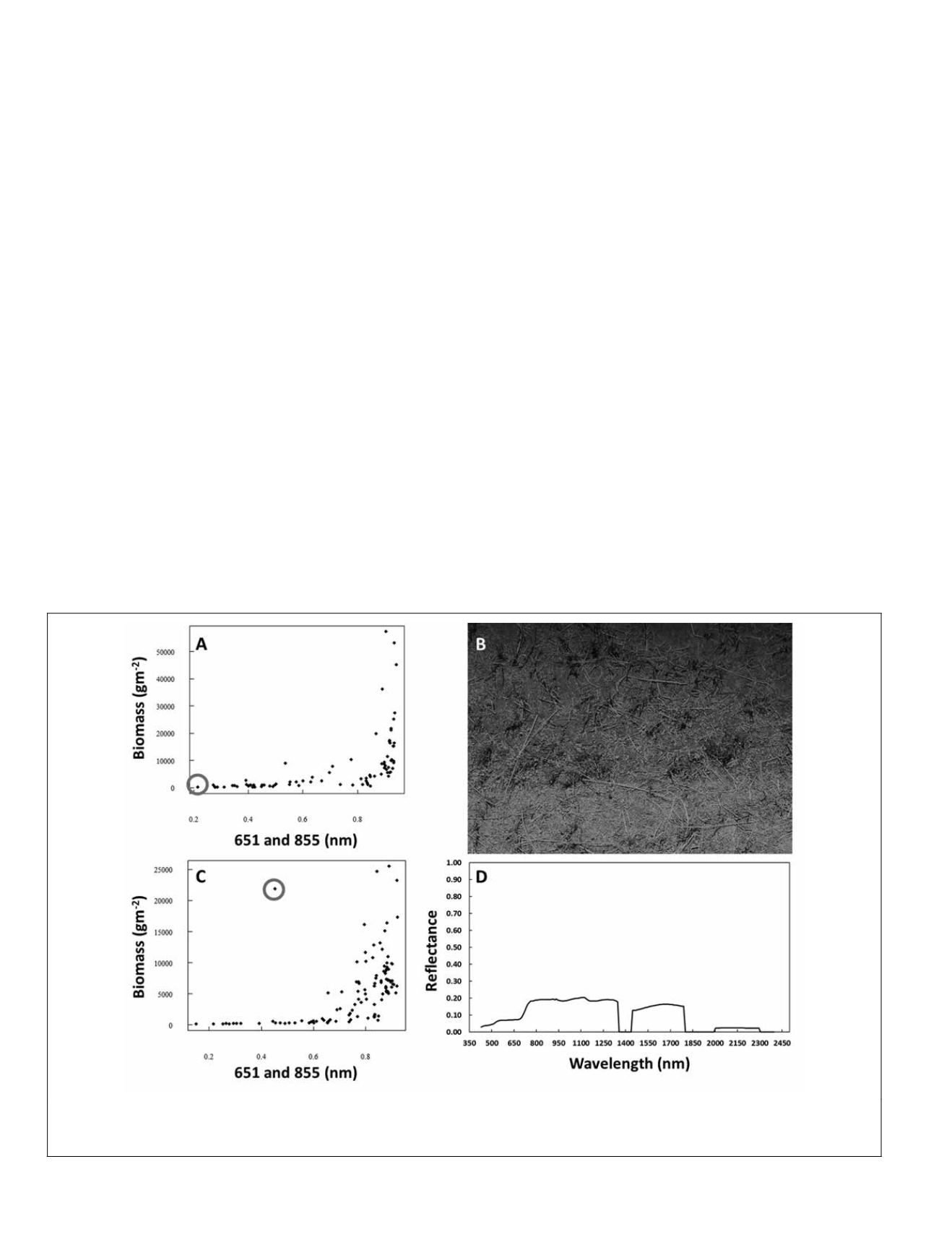
vegetation at major spectral inflection points. Inflection points
(e.g., red-edge) are wavelengths at which dramatic changes in
absorption by and reflectance from the canopy occur. Cubic
spline functions were fit to each spectrum using the “stats”
package available in R
®
) and the first and
second derivative of the function at each wavelength was
computed and used along with the untransformed spectra for
model-building. Other transformations commonly used in
hyperspectral analysis, such as inverse-log, which generates
a pseudoabsorbance curve (Serrano
et al
., 2002), were also
compared, but showed no advantage over the untransformed
or derivative spectra during the model-building process.
Additional preprocessing was performed by comparing
HNB
s (predictors) to the biomass data itself. In this phase, the
biomass was log-transformed, and a 70 to 30 percent split
random sample stratified by crop type was created for model
calibration and validation, respectively. This yielded 368
samples for calibration and 159 samples for validation. Outli-
ers were detected from scatter and studentized residual plots
of biomass for each crop type versus two-band
HVI
s identified
to be sensitive to crop biomass in Thenkabail
et al
. (2013)
and from biomass and two-band cross correlation matrices
detailed in the
Single and Two-band
HNB
Band Relationship
Subsection
. In each case, the best two-band
HVI
using this
method,
one red and
NIR HVI
(651 and 855 nm), one green
HVI
(550 and 651 nm), and one
SWIR
1
HVI
(651 and 1649 nm) were
chosen to generate the plots. Potential outliers were flagged
as data points with absolute studentized residuals greater
than two. The outliers were typically common to all plots for
each crop type, however the outliers were further scrutinized
before a final decision was made on omission. In the calibra-
tion dataset, five outliers were detected for alfalfa, cotton, and
rice, while only three were detected for maize. In the valida-
tion dataset, four outliers were detected for rice, alfalfa, and
maize, while only one outlier was detected for cotton. Outli-
ers were due to corrupted data or irregular sampling, namely
large biomass when vegetation was sparse (Figure 1a and 1b)
and anomalously high or low spectra across wavelengths,
which over-predicted or under-predicted biomass, respective-
ly (Figure 1c and 1d). The former occurred when a biomass
sample was taken outside the spectroradiometer
FOV
, because
biomass was insufficient within the spectroradiometer
FOV
to
take a sample. The latter occurred when white reflectance cal-
ibration was infrequent in the presence of clouds, sun angle
was low, or the fore-optic was off-nadir.
Band Selection for Biomass Prediction
The development of an empirical
HNB
biophysical model is
complex: several bands must be analyzed together, which often
exhibit strong multicollinearity; the number of predictors often
exceeds the number of dependent samples, so that rules must
be applied to reduce the Hughes effect; and model parsimony
must be achieved to prevent over-fitting. From the data mining
techniques employed by the Thenkabail studies highlighted
in the introduction, we selected three to develop empirical-
ly-based predictions of crop biomass: two-band
NB HVI
s select-
ed from lambda-lambda (R
2
) contour plots, multiple band-
HVI
s
(
MB-HVI
s) developed from Sequential Search Methods (
SSM
),
and
MB-HVI
s developed from Principal Component Regression
(
PCR
). Each method has unique advantages and disadvantages,
which will be discussed below. Single band correlation plots
were used to show which spectral ranges (visible,
NIR
,
SWIR
1,
and
SWIR
2) had the strongest relationship with biomass and to
detect important inflection points.
Single and Two-band HNB Band Relationship
Figure 1. Scatter plots of biomass (gm
-2
) versus two-band HVI (λ855 − λ651)/ (λ855 + λ651) for (A) alfalfa during sprouting 2011 and (C) cot-
ton during flowering in 2011. The number of samples used is 80 and 104, respectively. One alfalfa and cotton outlier have been circled and
correspond to low vegetation cover for alfalfa shown in (B) and an off-nadir fore-optic and low reflectance shown for cotton shown in (D).
760
August 2014
PHOTOGRAMMETRIC ENGINEERING & REMOTE SENSING


